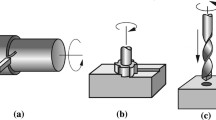Abstract
This contribution presents a physical cutting process model based on the Discrete Element Method (DEM), which allows the simulation of dynamic and thermal interactions in metal cutting. Core component of the approach is the DEM model of a solid with elastic-plastic deformation modes, which is verified in standardized tensile and Charpy impact tests as well as other non-standardized tests. The model is enhanced such that the thermo-dynamics of a solid due to heat conduction can be included, which is also verified in different tests. The applicability to model-cutting processes is shown in the simulation of orthogonal cutting processes. The results of the simulation are compared to experimentally obtained results for both forces as well as temperatures. For verification purposes, an FEM model is made, which predicts both forces on the tool as well as temperatures
Access this chapter
Tax calculation will be finalised at checkout
Purchases are for personal use only
Preview
Unable to display preview. Download preview PDF.
Similar content being viewed by others
References
Tsai, L.-W.: Robot Analysis – The Mechanics of Serial and Parallel Manipulators. John Wiley & Sons, New York (1999)
Merlet, J.-P.: Parallel Robots. Kluwer Academic Publishers, Dordrecht (2000)
Preumont, A.: Mechatronics – Dynamics of Electromechanical and Piezoelectric Systems. Springer, Dordrecht (2006)
Heisel, U., Storchak, M., Stehle, T.: Einfluss der Umgebungstemperatur beim orthogonalen Zerspanen. wt Werkstattstechnik Online 100, 89–98 (2010) (in German)
Frohmüller, R., Knoche, H.-J., Lierath, F.: Aufbau und Erprobung von Temperaturmesseinrichtungen durch das IFQ im Rahmen des Schwerpunktprogramms Spanen metallischer Werkstoffe mit hoher Geschwindigkeit. Spanen metallischer Werkstoffe mit hohen Geschwindigkeiten Kolloquium des Schwerpunktprogramms der DFG, 108–115 (1999) (in German)
Körtvelyessy, L.V.: Thermoelement Praxis. Vulkan Verlag, Essen (1981) (in German)
Müller, B.: Thermische Analyse des Zerspanens metallischer Werkstoffe bei hohen Schnittgeschwindigkeiten. Dissertation, RWTH Aachen (2004) (in German)
Heisel, U., Storchak, M., Stehle, T., Korotkih, M.: Temperaturbestimmung in den Zerspanzonen. wt Werkstattstechnik Online 100, 365–370 (2010) (in German)
Heisel, U., Krivoruchko, D.V., Zaloha, V.A., Storchak, M.: Cause Analysis of Errors in FE Prediction of Orthogonal Cutting Performances. In: 10th CIRP International Workshop on Modeling of Machining Operations, pp. 141–148 (2007)
Heisel, U., Kryvoruchko, D.V., Zaloha, V.A., Storchak, M., Emelyanenko, S., Selivonenko, S.N.: Finite Element Analysis of Cutting Force Dynamics. In: Proceedings of the 11th CIRP Conference on Modeling of Machining Operations, September 16-18, pp. 163–170 (2008)
Fleissner, F.: Parallel Object Oriented Simulation with Lagrangian Particle Methods. Schriften aus dem Institut für Technische und Numerische Mechanik der Universität Stuttgart, Bd. 16. Shaker Verlag, Aachen (2010)
Geradin, M., Rixen, D.: Mechanical Vibrations. John Wiley & Sons, Chichester (1998)
Lankarani, H.M., Nikravesh, P.E.: A Contact Force Model with Hysteresis Damping for Impact Analysis of Multibody Systems. Journal of Mechanical Design 112, 369–376 (1990)
Liu, K., Gao, L., Tanimura, S.: Application of Discrete Element Method in Impact Problems. JSME International Journal, Series A 47, 138–145 (2004)
Fleissner, F., Gaugele, T., Eberhard, P.: Application of the Discrete Element Method in Mechanical Engineering. Multibody System Dynamics 18, 81–94 (2007)
Gaugele, T., Fleissner, F., Eberhard, P.: Simulation of Material Tests using Meshfree Langrangian Particle Methods. Proceedings of the Institution of Mechanical Engineers, Part K: Journal of Multi-body Dynamics 222(K4), 327–338 (2008)
DIN10045, Kerbschlagbiegeversuch nach Charpy. Deutsches Institut für Normung e.V., Berlin (1991)
Gaugele, T., Eberhard, P., Storchak, M., Heisel, U.: A Discrete Material Model used in a Co-simulated Charpy Impact Test and for Heat Transfer. In: Proceedings of the 1. International Conference on Process Machine Interactions, pp. 361–369 (2008)
Tychonoff, A., Samarski, A.: Differentialgleichungen der mathematischen Physik. Deutscher Verlag der Wissenschaften, Berlin (1959) (in German)
Jaspers, S., Dautzenberg, J.: Material Behavior in Metal Cutting: Strains, Strain Rates, and Temperatures in Metal Cutting. Journal of Materials Processing Technology 121, 123–135 (2002)
Gaugele, T.: Application of the Discrete Element Method to Model Ductile, Heat Conductive Materials. Dissertation, University of Stuttgart (2011) (submitted)
Eberhard, P., Gaugele, T.: Quasi-static and dynamic properties of separable continua based on Lagrangian Particle Methods. In: Proceedings of the International Conference on Particle-Based Methods, Fundamentals and Applications (Particles 2009), pp. 398–401 (2009)
Gaugele, T., Eberhard, P., Fleissner, F.: Particle Methods Used to Model Cutting Processes Including Heat Conduction. In: Proceedings of the International Conference on Particle-Based Methods, Fundamentals and Applications (Particles 2009), pp. 142–145 (2009)
Author information
Authors and Affiliations
Editor information
Editors and Affiliations
Rights and permissions
Copyright information
© 2013 Springer-Verlag Berlin Heidelberg
About this paper
Cite this paper
Eberhard, P., Heisel, U., Storchak, M., Gaugele, T. (2013). Dynamic and Thermal Interactions in Metal Cutting. In: Denkena, B., Hollmann, F. (eds) Process Machine Interactions. Lecture Notes in Production Engineering. Springer, Berlin, Heidelberg. https://doi.org/10.1007/978-3-642-32448-2_14
Download citation
DOI: https://doi.org/10.1007/978-3-642-32448-2_14
Publisher Name: Springer, Berlin, Heidelberg
Print ISBN: 978-3-642-32447-5
Online ISBN: 978-3-642-32448-2
eBook Packages: EngineeringEngineering (R0)



